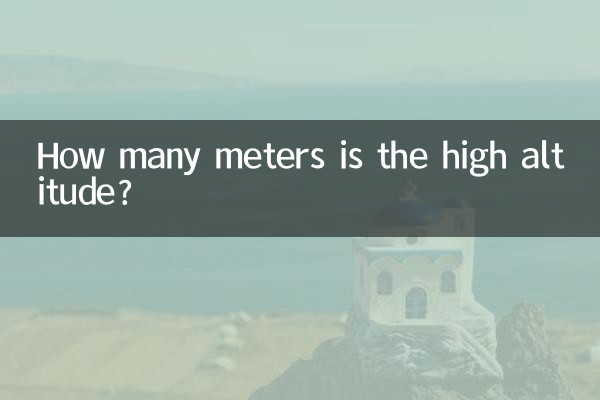How many meters is the high altitude?
The definition of high-altitude areas varies depending on the scenario, but generally refers to areas where the altitude exceeds a certain threshold. The following is a detailed analysis of high altitude, combined with hot topics and structured data in the past 10 days.
1. Scientific definition of high altitude

The classification criteria for high altitude vary slightly in different fields:
| Altitude range (meters) | Classification | typical effects |
|---|---|---|
| 1500-2500 | medium altitude | Mild hypoxia, suitable for most people |
| 2500-3500 | high altitude | Altitude sickness may occur |
| 3500-5500 | extremely high altitude | Requires an adaptation period and is not suitable for long-term living |
| 5500 and above | extreme altitude | It is extremely difficult for human beings to survive |
2. Recent hot topics related to high altitude
1.Expansion of high-altitude section of Qinghai-Tibet Railway: China announced that it will extend the Qinghai-Tibet Railway, with some sections exceeding 4,000 meters above sea level, raising concerns about the difficulty of the project and the health of workers.
2.High altitude mountaineering accident: An avalanche occurred on the southern slope of Mount Everest in Nepal, causing many casualties and once again triggering discussions on safety standards for high-altitude mountaineering.
3.New research on altitude training: Sports scientists published a paper stating that 2500-3000 meters is the optimal height for altitude training. The relevant data are as follows:
| Training height (meters) | RBC increase rate | Maximum oxygen uptake increased |
|---|---|---|
| 2000 | 8-12% | 3-5% |
| 2500 | 12-15% | 5-8% |
| 3000 | 15-18% | 8-10% |
3. World-famous high-altitude locations
Here are some of the world's most famous high-altitude locations and their characteristics:
| Place | Altitude (meters) | feature |
|---|---|---|
| Everest | 8848.86 | world's highest peak |
| La Paz (Bolivia) | 3640 | The world's highest capital city |
| Tibet Nagqu | 4500 | China's highest city |
| Atacama Observatory | 5050 | One of the world's tallest observatories |
4. Effects of high altitude on human body
As altitude increases, the human body undergoes a series of physiological changes:
| Altitude (meters) | Atmospheric pressure (hPa) | blood oxygen saturation | Common symptoms |
|---|---|---|---|
| 0 | 1013 | 98-99% | none |
| 2500 | 750 | 92-95% | mild headache |
| 3500 | 650 | 85-88% | Obvious altitude sickness |
| 5000 | 540 | 75-80% | severe discomfort |
5. Special phenomena in high-altitude areas
1.low boiling point: At an altitude of 3,000 meters, the boiling point of water is about 90°C, which affects cooking.
2.UV enhanced: For every 300 meters of altitude increase, UV intensity increases by 4%.
3.special ecosystem: For example, the Tibetan antelope on the Qinghai-Tibet Plateau has adapted to the low-oxygen environment.
6. High-altitude travel recommendations
1.step by step: It is recommended that the climb should not exceed 300-500 meters per day.
2.Essential items:Oxygen bottle, sunscreen, sunglasses.
3.health monitoring: Pay attention to changes in heart rate and blood oxygen.
High altitude areas are both unique and challenging, and understanding these facts will help you better explore these magical areas.

check the details

check the details